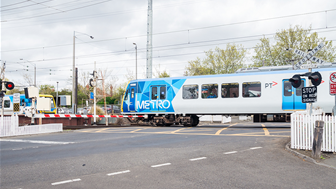New wearable technology is now available to Australian diabetes sufferers, promising an end to regular blood tests required throughout the day.
Abbott’s FreeStyle Libre is a flash glucose monitoring system that uses a sensor worn on the back of the arm and a reader that scans for a glucose profile.
The water-resistant sensor is the size of two stacked 20-cent coins and can be worn for up to 14 days, collecting glucose readings day and night.
A small filament inserted just under the skin continuously stores glucose in the interstitial fluid, and the whole sensor is held in place with an adhesive pad.
Data is displayed on the reader in a visual chart known as the Ambulatory Glucose Profile, and unlike existing continuous glucose monitoring systems, does not require calibration through blood samples extracted by regular finger pricks.
When the reader is passed over the sensor, a real-time glucose result is provided in under a second, and also displays an eight-hour history as well as a trend arrow that estimates any expected increase or decrease in glucose levels in the near future.
Peter Chalikias, Abbott’s Australian regional director, told IoT Hub that technologies like wearables and sensors satisfy the increasing requirement for rich data to enable health care professionals to provide better and more individualised treatment.
“In the healthcare space, wearable technology and sensors allow us to collect and collate important data from our bodies and use that information to modify treatment and lifestyle,” Chalikias said.
“For the 1.7 million people living with diabetes in Australia, having access to live and historical insights on glucose trends means they can better manage their diabetes daily, understand the impact of their actions on their glucose levels, and live healthier lives.
“Seeing the complete glycaemic picture provides health care professionals with the vantage point to link glucose trends to clinical decision-making and makes it easier for them to have conversations with patients as to what their glucose profiles look like.”
Sensor-driven diabetes monitoring ‘a revelation’
Associate Professor Neale Cohen, an endocrinologist and clinical researcher at the Baker IDI Heart and Diabetes Institute, has seen his fair share of continuous glucose monitoring solutions, and sees the FreeStyle Libre as a significant step forward in advancing diabetes management.
“Up until now, current continuous glucose monitoring systems have not had a very good uptake because of a number of factors,” Cohen told IoT Hub.
“One of them is cost, but the other one is that if you even if you wear a device that continuously measures your glucose, you still had to calibrate that device a few times a day with finger pricking and blood glucose measurements, which half defeats the purpose in some ways.
“A Type I diabetes sufferer generally needs to prick their finger four to six times a day on average just to monitor and control their sugars, and the process itself becomes one of the most difficult management issues that we see.”
Cohen said the ability to monitor in real-time is a revelation for the industry, and teaches the patients and clinicians a significant amount about their conditions on a day-to-day basis.
He also sees future potential to collect this level of patient data on an aggregated and anonymised basis as useful for future diabetes research.
“We need to learn a lot more about what happens to blood glucose levels in various circumstances,” he noted.
“For example, we have so little knowledge of what happens to blood glucose levels during various types of exercise, and every type of exercise has a different response.
“For food, we’ve never really been able to assess high-protein versus high-carbohydrate versus high-fat mixes of food, and this sort of information we can now get is going to be invaluable.”
Cohen hopes the platform will eventually connect to smartphone devices instead of using a bespoke scanner to take and analyse glucose readings.
“I’d expect patients to be able to download an app to their smartphones and upload glucose results, and even take readings while you’re driving,” he said.







